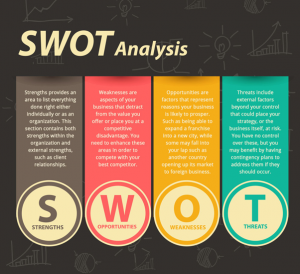Strategic management – The means to achieving your business goals
What is strategic management?
To understand strategic management better, it is wise to start at its root, which the word “strategy”. A strategy is the long term plan of action designed to achieve a set of goals or objectives. It is a top- level management plan designed to strengthen the performance of the organisation.
A strategy is different from tactic as a strategy is the top-level directions whereas tactic is the method in which the objectives of the strategy are completed. The table below should give an idea of how the two work together to achieve the business objectives.

Now you may be wondering, is strategic management as important as they say it is?
As we can see, strategic management is the process of chalking out and implementing the strategy of the business to help it meet its objectives.
It is widely accepted and documented that good strategic management practices provide both financial and non-financial benefits to the organisation. Good strategic management practises help the organisation with change management and staying updated in the ever-changing business environment. It helps to stay ahead of the competition and to create new demand for the products or services of the company.
It helps the top-level management achieve the long terms goals of the organisation. Without strategic planning and management, no organisation can reach its goals, and for that matter, may not even have a proper plan of action to achieve its mission.

Because of the undeniable benefits of strategic management, most organisations are now embracing the idea of implementing strategic management regardless of their size and line of business. Consistent monitoring and evaluation, which is part of the strategic management process ensure that the organisation stays on track in so far as its goals and objectives are concerned.
So what are the basic steps of strategic management?
Strategic management consists of 5 main steps:
- Setting up a goal
- Situation analysis
- Strategy formulation
- Strategy implementation
- Strategy evaluation
Below, I have explained each one briefly.
1. Setting up a goal:
The first step of any strategy is to identify the long term vision of the organisation based on its mission statement. The vision statement encapsulates the idea of where the organisation wants to be in the future. This serves as a backbone of the strategic management process.

Photo by JOHN TOWNER on Unsplash
2. Situation analysis
Once the vision of the organisation is defined, the next step is to obtain information helpful to obtain the goals of the organisation. One tool that can be used to gather information is SWOT analysis (stands for “Strength, Weakness, Opportunity and Threats”). As part of SWOT, we look at the organisations,
- Strengths – These are things that the organisation does well due to which it has an advantage
- Weakness – These are things where the organisation is lacking or does poorly, which puts it at a disadvantage
- Opportunity – These are external factors which help the organisation to obtain the objectives of its plan like competitive advantage, growth, profit, etc.
- Threats – These are external factors which could compromise the company’s ability to achieve its objectives
The strengths and weaknesses are internal factors to the organisation under the present situation whereas the opportunities and threats are the external factors and apply to both the present as well as the future situation.

Photo by Dominic Hawk on Flickr.
3. Strategy formulation:
After identifying the relevant information to the tools available such as SWOT analysis, we need to design a framework which will help us reach our vision. This framework should address the following points:
- Current situation – This is done by answering the question “Where are we now?” We can do this by analysing the information obtained from Step 2: Situation analysis.
- Future goal – This is derived based on the vision statement we came up with in Step 1: Setting up a goal. The goals can be both long and short term. This will answer the question “Where do we want to go?”
- Plan of action – The plan of action is a bridge that connects our current situation to the future goal. We have to keep in mind all the information we have till now while formulating the plan of action. The plan must answer the question “How do we get there?”
- Measurement – The final step of strategy formulation is to develop a method on how the progress in the strategy will be monitored. This will answer the question “How will you know you’ve got there?”
 Photo by Glenn Carstens-Peters on Unsplash
Photo by Glenn Carstens-Peters on Unsplash
4. Strategy implementation:
Strategy implementation is a stage where the plan becomes action. For the successful implementation of strategy, it has to be executed in smaller actionable parts of smaller timeframes which would each have specific objectives and activities. This may also entail a change in the reward system or mindset of the people in the organisation, including the leaders to be compatible with the new strategy.
 Photo by Jakob Owens on Unsplash
Photo by Jakob Owens on Unsplash
5. Strategy evaluation:
This is the final stage of the strategy management process. The strategy execution has to now be evaluated against planned benchmarks to check if the same is being achieved. If not, then the reasons for the same must be ascertained, such as an unrealistic plan or unforeseen events. In case the execution is not getting the planned results, then we go back to step one and evaluate the entire process from the beginning.
An interesting thing to note is that even if the current plan has been properly implemented, changing business environment conditions require changing plans and strategies. This key difference in understanding that change is inevitable and how to foresee and adapt to the same is what sets out the best strategic management practices. In other words, the strategy itself should be flexible enough to be tweaked as demanded by the circumstances of the business and changes in the environment.
 Photo by Siora Photography on Unsplash
Photo by Siora Photography on Unsplash
As we can see, strategic management is a continuous process and it is in the organisation’s best interest to have a dedicated team of strategic managers at the helm to help it achieve its objectives. We at Leap are dedicated to providing the best strategic management solutions with staff having immense experience across various industries. Please do check out some of our case studies here.
